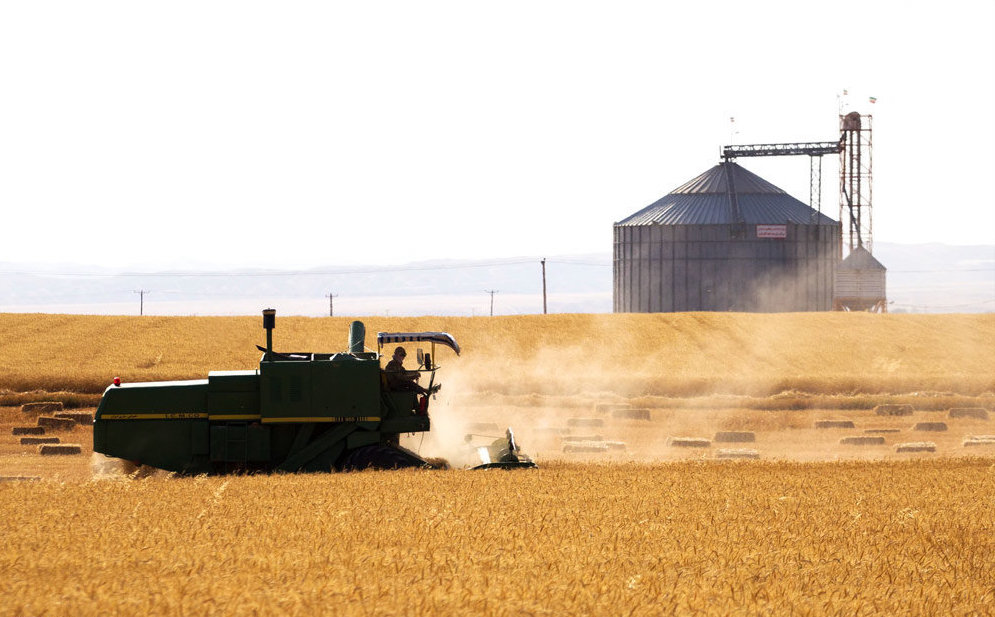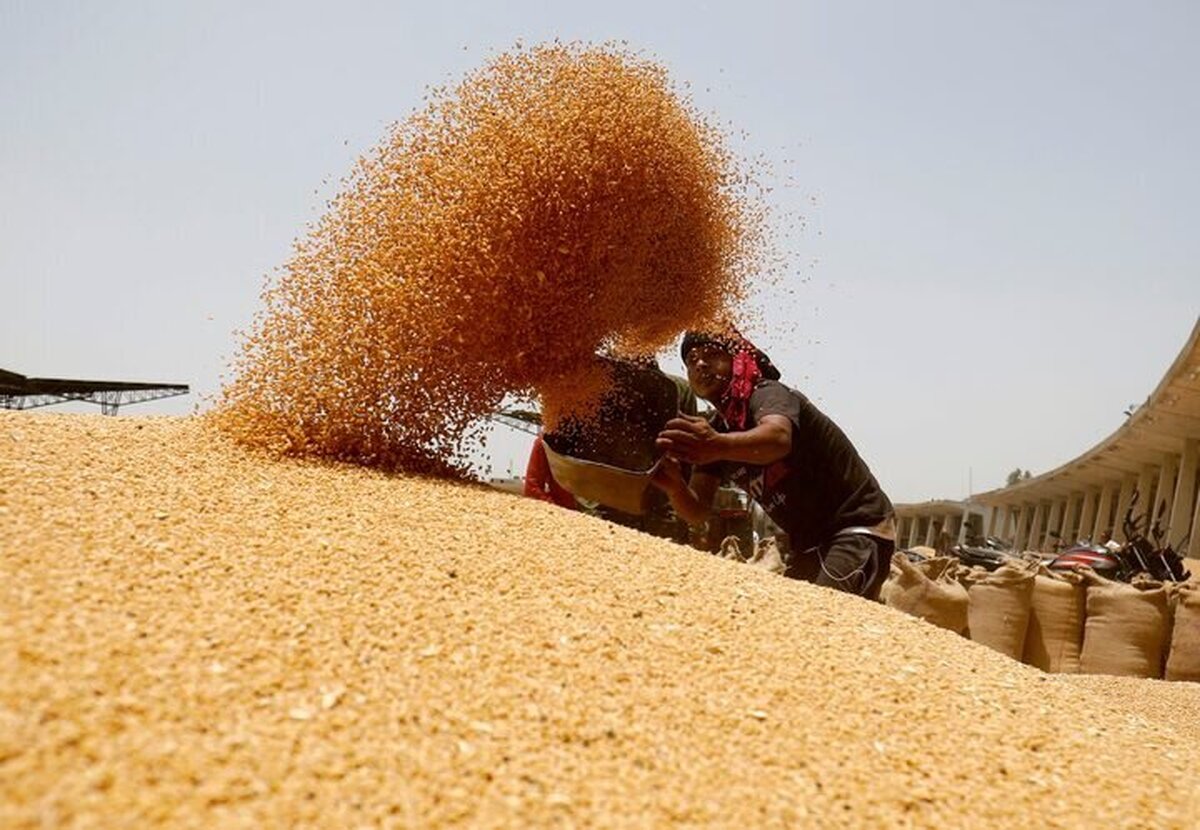
Iran Reports 32% Surge in Early Wheat Harvest

EghtesadOnline: The government has reported a considerable increase in its purchases of domestically-grown wheat in the 37 days ending May 3.
CEO of Government Trading Corporation (GTC) of Iran Saeed Raad said on Saturday that wheat purchases in seven provinces with warm weather in southern and southeastern Iran had reached 1 million tons in more than a month ending early April.
Raad said the figure showed an increase of 32% compared with the same period of 2022, Mehr News Agency reported.
The official said Iran’s southwestern province of Khuzestan accounted for 623,000 tons of wheat supply delivered to GTC silos over the period, adding that output in the provinces of Kerman and Fars also increased compared with the corresponding period of last year.
Iran buys a bulk of its domestically grown wheat under a guaranteed purchase program that offers farmers favorable prices and transport conditions.
Officials of GTC, which is a subsidiary of Iran’s Agriculture Ministry, expect domestic wheat purchases in the country could increase by 13% to 8.5 million tons this year.
The United Nation’s Food and Agriculture Organization estimated that 13 million tons of wheat were produced in Iran in 2022, over 28% more compared to 10.1 million tons in 2021.
The quarterly global Crop Prospects and Food Situation report’s forecast for 2023 production remains the same at 13 million tons.
Despite the solid rise in output, last year’s production was slightly below five-year average annual of 13.2 million tons, the report added.
According to FAO, Iran is among the world’s major producers of wheat.
Iran Buys More Russian Wheat Despite Payment Issues
The GTC reportedly purchased several hundred thousand tons of Russian milling wheat recently for April and May shipment.
The tender caught most of the market by surprise, especially with Iran’s wheat harvest expected to commence in May, UkrAgroConsult reported.
News of the deal came as vessels carrying more than 650,000 tons of Russian wheat remain stranded at the major Iranian ports of Bandar Imam Khomeini and Bandar Abbas, unable to discharge due to documentation issues and hard currency payment delays.
Some of the vessels have been at anchor in the Persian Gulf since September last year, as the Central Bank of Iran’s lack of foreign currency reserves severely hampers the flow of essential goods, such as wheat and sugar, into the country.
With the demurrage bills growing daily, Russia sent a trade delegation to Iran on Jan. 25 in an effort to resolve the issue. Negotiations resulted in an Iranian government agreement to pay for all agricultural products caught up by the payment delays. However, virtually nothing has been discharged and released by shippers since the meeting.
The quality of food imports once the cargoes are finally discharged is an escalating challenge due to the extraordinarily long period in the vessel holds.
The West’s sanctions on Iran over its nuclear program exclude food imports, but the restrictions have severely affected the country’s financial situation, necessitating complex and unreliable payment arrangements with international suppliers.
The value of Iranian rial has dropped significantly against the US dollar since the failure of nuclear talks with the West in September, exacerbating the dire situation.
Back in November last year, a report released by Iran’s Ports and Maritime Organization put the discharge backlog due to the payment delays at the port of Bandar Imam Khomeini alone at 37 vessels carrying 2.2 million tons of goods, including commodities such as wheat and sugar. The value of those distressed cargoes was put at more than $1 billion.
By early February, the Islamic Republic of Iran Customs Administration said at least 8 million tons of essential goods was sitting on ships anchored off the country’s Persian Gulf ports.
The recent deal is believed to be a government-to-government agreement that will most likely be executed by a select band of well-connected Russian exporters. As such, the extremely costly discharge delays will be mitigated, as these cheaper shipments will reportedly go straight to the front of the discharge queue.
Food Security Top Priority
Food security is a top priority of the Iranian government. Drought drastically decreased domestic production in the 2021 harvest, culminating in record wheat imports of 8 million tons in the year to June 2022.
In Iran’s crop year ending August 2022, the Agriculture Ministry reported wheat production of 11.5 million tons off 4.9 million hectares, an increase of 45% compared to the previous season. A far more favorable growing season, a 50% fall in the subsidized price for fertilizer and pesticides, and an increase in cultivation area following a 130% increase in the government’s guaranteed purchase price were the primary contributing factors.
Wheat is considered a staple in Iran, and the government purchases it from farmers every crop year to build up its reserves and regulate supply to the market over time. The government has purchased 7.5 million tons of wheat from local farmers following last year’s harvest, up from 4.5 million tons the previous year.
However, despite the significant jump in production, wheat imports are still expected to be around 5.5 million tons in the current marketing year, assuming the hard currency issues are resolved soon. In the five seasons prior to the fiscal 2021-22, wheat imports averaged just 1.2 million tons annually.
Iran was Russia’s third biggest wheat customer in the fiscal 2021-22, importing a total of 1.8 million tons, down 55% compared to 2,021 shipments of 4 million tons. The biggest importer of Russian wheat last year was Turkey with 4 million tons, down 5.2%, followed by Egypt, which registered a 12.6% rise to 3.5 million tons. Trailing Iran on the list was Saudi Arabia with 1.5 million tons, up 119%, and Algeria with 1 million tons, up 270%.
Iran’s barley production in its fiscal 2021-22 was up 11% to 3 million tons, on par with the average of the past five years. Imports are pegged at 2.7 million tons in the 2022-23 marketing year, slightly higher than the five-year average of 2.5 million tons as producers increase barley inclusion rates at the expense of wheat.



